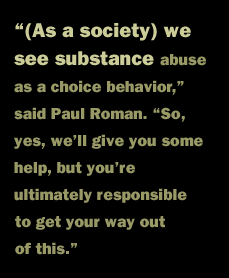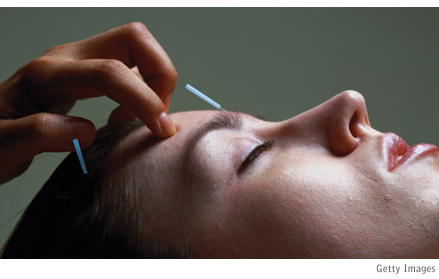


Sobering
Times
for
Treatment Centers
by Judy Bolyard Purdy
Intro | Private centers | Bigger menus | New directions


Bigger Menus, more choices
These days, private treatment centers are improving quality and expanding services to treat other addictions: gambling, illegal and prescription drugs, sex and Internet addictions, to name a few. Centers also are adjusting to changes in their clientele, who are now more likely to have multiple addictions, Johnson said.
“Center administrators will tell you that alcoholism really doesn’t exist the way it used to,” he said. “Administrators have told me countless times that people coming into treatment now are poly-drug addicts who abuse all sorts of things, not just alcohol and not just cocaine.”
More than half of the centers studied have enhanced traditional counseling and “talk” therapies with complementary treatments, such as acupuncture and motivational enhancement therapy. The researchers found a surprising 13 percent now offer acupuncture, for example.

Acupuncture - a complementary treatment for substance abuse — is offered at 13 percent of the private rehab centers in the study.
“There’s a whole movement at the National Institutes of Health to understand the role of complementary medicine in treatment outcomes — for example, the research on prayer, meditation, massage therapy and acupuncture,” Blum said. “And it's not just focused on substance abuse but all kinds of diseases — cancer, diabetes, etc. These don’t replace the main therapy; they are add-ons.”
But the researchers said they also found disappointments. Only 44 percent of the centers prescribed naltrexone, or ReVia®, which the FDA approved for alcohol addiction in 1995. The drug works as an alcohol antagonist, taking the pleasure out of using alcohol. People don’t get the good feelings — the “highs” — because the drug blocks the brain’s pleasure receptors.
“Why not give them some biomedical, biochemical or neurological help along the way? That's regarded as a good treatment practice,” Roman said. “And what we found is that it’s not being used very much at all.”
Their findings, published in the May issue of the Journal of Substance Abuse Treatment, show greater naltrexone use among centers with longer established programs and more experienced administrators, and among those with higher percentages of managed care coverage and higher proportions of relapsed patients in the overall caseload.
Roman said he believes prescription drugs are slow to take hold because of society’s attitudes.
“Drugs undermine the old paradigm of treatment,” he said. “They want you to take the naltrexone and keep going to AA meetings.
“(As a society) we see substance abuse as a choice behavior, so, yes, we’ll give you some help, but you're ultimately responsible to get your way out of this,” he said. “The idea of giving people a drug to help them just doesn’t fit with this notion that substance abusers have a medical problem that they're responsible for.”
Roman illustrated his point by contrasting attitudes between addiction and infections.
“If you have an infection, healthcare professionals don’t try to talk you out of it or counsel you on it,” he said. “Instead, they prescribe antibiotics to help you get better.”
The researchers are curious whether prescription drugs will lower the costs of addiction treatment.
“That’s not a question we can answer right now, but there’s certainly a hint that using drugs rather than talk to treat substance abuse is going to be cheaper in the long run,” Roman said.
The study also has turned up gender-based differences.
For example, women represent a higher proportion of Medicaid and Medicare patients, and they are more likely to be uninsured or underinsured. They also account for a higher proportion of patients at centers that offer onsite childcare and they are more likely to seek treatment at stand-alone clinics.
“Free-standing centers may offer women an increased sense of anonymity, as opposed to having to go in and out of the hospital, where there’s a bigger risk they’ll be seen,” Johnson said. “There is still, particularly for women, a major stigma attached to substance abuse treatment.”
Intro | Private centers | Bigger menus | New directions
For comments or for information please e-mail the editor: jbp@ovpr.uga.edu
To contact the webmaster please email: ovprweb@uga.edu
![]()